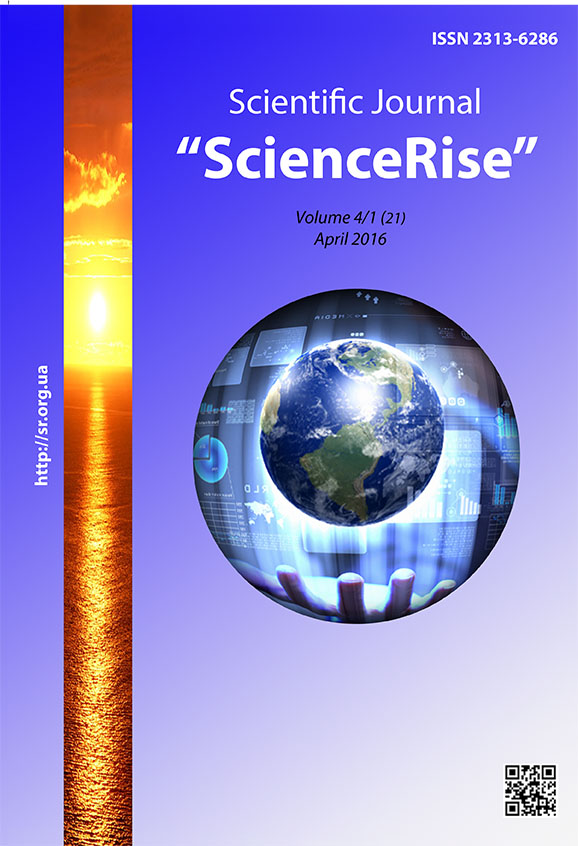Аналіз еколого-географічних особливостей центрів походження Triticum spelta і перспективи поширення культури в Україні
DOI:
https://doi.org/10.15587/2313-8416.2016.66199Ключевые слова:
спельта, ГІС, моделювання, біокліматичні показники, центри походження, Triticum spelta, гліадиниАннотация
Вивчення особливостей еколого-географічних центрів походження Triticum spelta вказують на високу екологічну пластичність «дикороса альпійських прерій». Лімітуючими факторами, які визначають можливість рослини рости, розвиватися, розмножуватися та проявляти бажані господарські якості в Україні є максимальна температура самого теплого місяця та показники pH ґрунту
Библиографические ссылки
Flyaksberher, K. A. (1935). Wheat. Vol. 1. Moscow; Leningrad: Gos. Publishing House kolhoznoy and sovhoznoy lit-ry, 262.
Zhukovski, P. М. (1971). Cultural plants and their relatives. Leningrad: Kolos, 448.
Kuckuck, H., Schiemann, E. (1957). Über das Vorkommen von Spelt und Emmer (Triticum spelta L. und T. dicoccum Schübl.) im Iran. Z. Pflanzenzüchtung, 38, 3833–3896.
Kihara, H., Yamashita, K., Tanaka, M. (1965). Morphological, physiological, genetical and cytogenetical studies in Aegilops and Triticum collected from Pakistan, Afghanistan and Iran. Results Kyoto Univ. Sci. Exp., 1, 1–118.
Mustafaev, I. D. (1964). Wheats of Azerbaijan and their value are in a selection and process of formation of forms. Bobrovsk: VNIIS.
Veremeychyk, A., Pashkevich, G. (2004). Peculiarity of ancient settlement in the tract Ovramenko circle. Archaeological research of L’viv University, 7, 270–281.
Romanova, Y. A., Gubareva, N. K., Konarev, А. В. (2001). Research of collection of type of wheat of Triticum spelta on polymorphism of gladin. Geneticist, 37 (9), 1258–1265.
Blatter, R. H. E., Jacomet, S., Schlumbaum, A. (2004). About the origin of European spelt ( Triticum spelta L.): allelic differentiation of the HMW Glutenin B1-1 and A1-2 subunit genes. TAG Theoretical and Applied Genetics, 108 (2), 360–367. doi: 10.1007/s00122-003-1441-7
Species. Global Biodiversity Information Facility. Available at: http://www.gbif.org/species
Data for current conditions (1950–2000). WorldClim – Global Climate Data. Available at: http://www.worldclim.org/current
McFadden, E. S., Sears, E. R. (1946). The origin of Triticum spelta and its free-thresching hexaploid relatives. Jounal of Heredity, 37, 107–116. Available at: http://www.oxfordjournals.org/our_journals/jhered/freepdf/37-107.pdf
Karpun, Y. (2004). Fundamentals yntroduktsyy plants. Hortus botanicus, 2, 17–32. doi: 10.15393/j4.art.2003.168
Characteristics of agricultural land by the reaction of soil solution on the results of 9 agrochemical certification round (2006–2010). Institute of soil conservation Ukraine. Available at: http://www.iogu.gov.ua/pasportizaciya/karty-po-vmistu-pozhyvnyh-rechovyn-rn-humus-fosfor-kalij/
Загрузки
Опубликован
Выпуск
Раздел
Лицензия
Copyright (c) 2016 Віталій Васильович Лапчинський

Это произведение доступно по лицензии Creative Commons «Attribution» («Атрибуция») 4.0 Всемирная.
Наше издание использует положения об авторских правах Creative Commons CC BY для журналов открытого доступа.
Авторы, которые публикуются в этом журнале, соглашаются со следующими условиями:
1. Авторы оставляют за собой право на авторство своей работы и передают журналу право первой публикации этой работы на условиях лицензии Creative Commons CC BY, которая позволяет другим лицам свободно распространять опубликованную работу с обязательной ссылкой на авторов оригинальной работы и первую публикацию работы в этом журнале.
2. Авторы имеют право заключать самостоятельные дополнительные соглашения, которые касаются неэксклюзивного распространения работы в том виде, в котором она была опубликована этим журналом (например, размещать работу в электронном хранилище учреждения или публиковать в составе монографии), при условии сохранения ссылки на первую публикацию работы в этом журнале .

